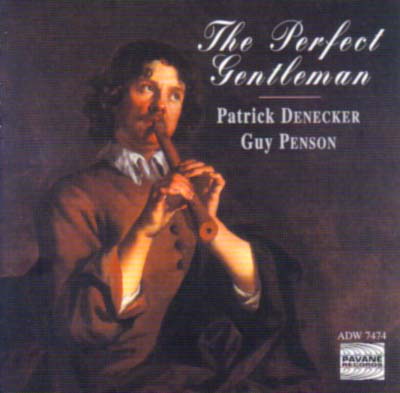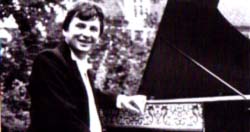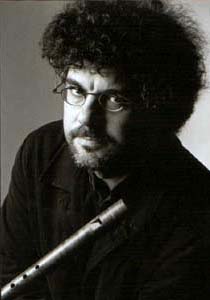 THE PERFECT GENTLEMAN
1 Mr. Shores Trumpet Tune J.
Shore
Trumpet Tune Anonymous
2 Match G. Bingham
Sybell H. Purcell
3 Johney Cock thy Beavor Anonymous
4 Italian Ground Anonymous
Ground H. Purcell
jigg G. Bingham
|
5 Suite n'8 M. Locke
Pavan
Ayre
Courant
Saraband
6 Ground after the Scotch
Humour N. Matteis
7 Almand W. Byrd
8 Rowland W. Byrd
9 Volta W. Byrd
10 The Witches' Second Dance Anonymous
Boffons J. Van Eyck
11 Sonata HWV 367a G. F. Hândel
Largo
Vivace
Furioso
Adagio
Alla breve
Andante
A tempo di Minuet
12 Scarborough Fair Anonymous
Scotch Air G. Bingham
13 Mr. Maule's favourite Anonymous
King of the Faeries Anonymous
14 Sonata A. Parcharn
|
Patrick
Denecker
Recorders
:
1 Soprano in C after P. Borkens by Alec
Loretto New Zealand
2 Soprano in C after Van Eyck by Sebastien
Lemaire Belgium
3 Alto in G after 1711, Century examples by
Stefan Blezinger Germany
4 Alto in F after P. Bresan by Fumitaka Saito
Netherlands
5 Tenor in D (Voice flute) after J.C. Denner
by Adrian Brown
Guy
Penson
Harpsichords
A Flemish harpsichord after Andreas Rockers
Antwerp 1640 by Chris Maene
B Flemish harpsichord after Rockers examples
Antwerp ca. 1730 by Chris Maene

THE
PERFECT GENTLEMAN
Dans son livre
'Music and Morals' du milieu du 19" siècle, H.R. Haweis
nous définit la musique anglaise comme suit: Music in England
has always been an exotic The Reformation music was all French
and Italian; the Restoration music (1650), « French and halj
German. No one will deny that Tallis, Farrant, Byrd, in Church
music - Morley, Word, WilbYe, in the madrigal, made a most
original use of their materials; but the materials were foreign,
fôr all that. Purcell, the Mozart of his time, was largely
French ... They did not writen for the people, the people did not
cure for their music. The music of the people was ballads - the
music qf the people is still ballads. Our national music vibrates
between «When other lips» and «Champagne Charley». These
ballads ofall kinds are not exotic: they represent the national
music of the English people.
Toujours
d'après Haweis, c'est sans doute le répertoire 'populaire' qui
constitue en fait la vraie musique anglaise. Ce même répertoire
servira d'ailleurs de point de repère pour bon nombre de
compositeurs anglais ultérieurs. Ces chansons n'ont rien
d'exotique, leurs caractéristiques principales étant une
mélodie enchanteresse et harmonieuse et un rythme entraînant et
vibrant.
Le choix des
pièces qui fait l'objet de cet enregistrement démontre
justement une symbiose parfaite entre cette musique 'populaire'
ou du peuple et la musique 'composée'. La flûte à bec, étant
l'instrument par excellence à la limite de ces deux cultures, se
voit attribuer- et à juste titre -un rôle de premier plan.
En effet, la
flûte à bec était l'instrument préféré des 'perfect
gentlemen'. Quiconque appartenant à la haute société,
désirant s'aventurer dans la musique, jouait de la flûte à
bec. Pourtant la difficulté des pièces faisait souvent obstacle
au musicien-amateur moyen. A remarquer aussi que l'on préférait
de loin les airs écossais et irlandais. Ces mélodies,
appartenant à la vie de campagne et 'à la rue', se faisaient
accepter petit à petit dans les salons et les théâtres. Ces
'tories' sont les vraies racines de la musique anglaise!
A partir du
milieu du 17""" siècle, l'Angleterre commençait
à attirer un grand nombre de musiciens et de compositeurs du
continent, le plus fameux d'entre eux étant G.F. Hândel. Ils y
retrouvaient un climat favorable à leurs créations et se
voyaient tout de suite débordés de travail. La ville de Londres
en particulier accueillait bon nombre d'entre eux dans ses
théâtres et ses maisons d'opéra.
Le style
'italien' détrônait peu à peu le style 'français', comme le
témoigne Roger North dans ses 'Memoirs':
The decay of
French music, in fàvour of the Italian, came on by degrees; its
beginning was occidental, and occasioned by the arrival of old
Nicholai Maiteis ; lie was a sort qfprecursor who made way for
what was tofollow.
Cet 'immigré'
Nicola Matteis, encouragé par des 'patroni', réussissait à
s'intégrer parfaitement dans la société anglaise. Violoniste
brillant et compositeur excellent, on l'a comparé au grand
Corelli. Charles
Burney, pour sa part, lui attribuait le 'raffinement' du goût
anglais. A part les suites contenant les mouvements de danse
usuels, il nous a laissé des pièces descriptives et plusieurs Grounds
comme celui intitulé Ground after the Scotch Humour évoquant
l'atmosphère caractéristique de la musique écossaise.
Un certain
George Bingham, gagnant sa vie comme professeur privé,
collectionnait et composait pour ses élèves un grand nombre de
pièces à une ou à deux flûtes à bec. Plus tard, il les a
fait éditer à Amsterdam (Pays-Bas). On y retrouve de vrais
petits chefs-d'oeuvre de la littérature pour flûte à bec comme
le Solo d'Andrew Parcham, une composition dans laquelle
les différentes parties se succèdent sans transition et qui se
sert d'une riche alternance d'états affectifs illustrant ainsi
de manière parfaite la rhétorique musicale. Ces recueils sont
la source unique en matière des pièces de ce genre.
Un autre genre
très en vogue qui s'est imposé même jusqu'à la fin du
19""" siècle était la 'country dance'. A ce
sujet, l'oeuvre de John Playford 'The English Dancing Master'
(17,1 siècle) nous fournit un trésor 'inépuisable' en matière
de musique de danse, d'ailleurs pour la plupart anonyme.
Ces airs
préférés réapparaissaient plus tard dans les opéras et
toutes sortes de pièces de théâtre. Les deux pièces anonymes
Mr. Maule's favourite en King of the Faeries se situent
dans, le même style. Au cours du 18""" siècle,
la 'country dance' a trouvé son pareil en France en la
,contredanse'. La mélodie du chant populaire
Scarborough
Fair, plus ancienne encore, apparaît au cours des siècles
sous plusieurs formes.
Suite au traité
important concernant les diminutions pour viole de gambe datant
de 1659 de la main de Christopher Simpson, l'oeuvre 'The Division
Flute' apparaît un demisiècle plus tard en 1706. L'auteur y
démontre l'art de l'improvisation et de la diminution sur une
basse ostinato. Les deux pièces An Italian Ground et Johney
Cock thy Beavor sont sorties de ce recueil. Comme dans la
musique de jazz, les variations multiples reprenaient, de façon
improvisée, les thèmes retirés de danses célèbres ou de
'ballads'. Le Ground de H. Purcell est à cet égard une
illustration parfaite et réservée. Le premier but de cette
musique était de s'amuser et dans ce sens-là (presque) tout
était possible. On donnait libre expression à l'inspiration et
aux capacités techniques. Cette liberté dans la pratique
entraînait de nouvelles expériences qui à leur tour
engendraient d'autres pièces musicales.
Les Trumpet
Tunes constituaient un genre préféré et très
reconnaissable. Ces pièces en effet se voulaient imitatives de
la musique pour trompette, devenue célèbre grâce à des
virtuoses comme John Shore. En outre, l'intérêt pour la musique
'militaire' et 'guerrière' invitait à composer des marches et
des Itrumpet tories' pour d'autres instruments encore. Dans ce
cadre-là, on doit situer la pièce Sybell de H. Purcell, qui a
recours à un extrait d'un opéra de Lully.
A part la
musique religieuse, Matthew Locke s'occupait en outre de la
musique pour théâtre, la 'incidental music'. Sa notoriété
ultérieure pour tant comportait surtout ses recueils de musique
instrumentale
Sa niusique
faisait preuve d'une solidité, considérée néanmoins comme
désuète par certains de ses contemporains. Quoi qu'il en soit,
son ami H. Purcell lui devait beaucoup et lui succéda conime
'Composer in Ordinary te, the King'. Dans la petite Suite n' 8
de son recueil 'ffor seaverall ffriend,,,", les parties
lentes, harmoniquement intéressantes (Pavan et Ayre), s'allient
à des mouvements de danse plus légers comme Courant et
Saraband.
Boffons excelle
en matière d'art des variations, non pas sur un thème mais sur
une basse.
Cette pièce
'contagieuse' a été reprise plus tard par le carillonneur
aveugle d'Utrecht (Pays-Bas) Jacob Van Eijek et on la retrouve
également dans quelques variations pour le virginal de Byrd et
de Bull.
La Sonate HWV
367a de Hândel fait partie d'une série d'autographes qui
sont conservés dans le Fitzwilliam Museum à Cambridge. Cette
'Sonata da Camera' italienne contient une 'Hornpipe' anglaise
dans le second mouvement.
Patrick Denecker
Traduction : Brigitte Hermans

THE
PERFECT GENTLEMAN
In the
middle of the 1911 century, H.R. Haweis, in his book «Music and
Morals», described English music as follows :
Music in
England bas always been an exotic ... The Rejormation
music was all French and Italian, the Restoration music
(1650), half>French and half German. No one will deny
that Tallis, Farrant, Byrd in Church Music-Morley, Ward,
Wilbye, in the madrigal, made a most original use of
their materials; but the materials werejoreign, for all
that. Purcell, the Mozart of his time, was largely French ...
They did not write for the people, the people did not
carefor their music. The music of the people was ballads -
the music of the people is still ballads. Our national
music vibrates between «When other lips» and «Champagne
Charley». These hallads of all kinds are not exotic; they
represent the national music of the English people.
According te,
Haweis, it is the common man's repertory which constitutes real
English music, something which later English composers were te,
continually acknowledge. The songs of this repertory are anything
but exotic, characterised as they are by attractive melodies and
rousing rhythms. The collection of picces on this recording shows
a perfect symbiosis between popular and art music. In tact the
recorder itself occupies a position on the dividing fine between
these two cultures, which makes it an ideal instrument for this
literature.
The recorder was
exceptionally suited for «perfect gentlemen», being played by
men of rank wishing to travel the highways and by-ways of music.
High technical demands however, placed some of the literature
beyond the reach of the model amateur musician. Noticeable was
the preference for Scottish and Irish melodies, which made their
way from the country-side, via the streets and drawing-rooms, to
the salons and theatres. The roots of English music are to bc
found in these melodies and dance-tunes.
From the middle
of the 1711 century onwards, England exerted a strong pull on
musicians and composers from the continent, of whom Hândel was
the most famous. There they found what they were looking for: a
market-place for their compositions and, more importantly, work
in abundance. It was particularly to London that large numbers of
continental composers flocked, finding work in the many theatres
and opera-houses there.
Gradually the
French style began to give way te, the Italian, as witnessed by
Roger North in his memoirs:
The decay
qfFrench music, in favour (if the ludion, came on bv degrees; its
bcginning was accidental, and occasioned ffil the arrival
of old Nicholai Matteis; he was a sort ofprecursor who made
wayfor what was to.follow.
This Nicola
Matteis was one of many immigrants who, encouraged by several
«patroni», were able te, work themselves into English society.
He was an exceptional violinist and composer, likened by
connoisseurs to Corelli. Even Charles Burney credited him with
the refining of English taste. Besides suites the usual dance
forms, he also composed descriptive pieces and several containing
Grounds, such as after the Scotch Humour, in which
bc evokes a typical Seottish atmosphere.
One George
Bingham, who probably earned lus living as a private teacher,
collected and composed pieces for one and two recorders for his
pupils, which he later had published in Amsterdam. Gems of the
recorder literature are to be found here, including Andrew Parcham's
Solo, a thoroughly worked out piece which, with its rich
alternation of affects, serves as a perfect example of musical
rhetoric. Bingham's collections provide the sole source for
similar works.
Another genre
which was to remain fashionable until well into the 19"
century was the country dance. An in~exhaustible treasure-trove
of mostly anonymous dance music was provided by John Playford in
the 171" century in his «The English Dancing Master».
These tunes were so popular that they regularly turned up in
operas and other thcatre music. Both the anonymous Mr.
Maule'sfavourite and King ofthefaeries belong here.
During the course of the 1811 century, the country dance even
received its French counterpart: the contredanse. The still older
tune of the popular Scarborough Fair continued to surface
through time in many guises.
Following in the
footsteps of the important treatise on divisions for viol by
Christopher Simpson in 1659, there appeared in the 18th centory
«The Division Flute~~, demonstrating the art
of improvising
diminutions and variations on an ostinato bass. An Italian
Ground and Johney Cock thy Beavor are to bc found
here. Many variations incorporate quotations from other wellknown
dances and ballads, a procedure amicipating jazz techniques. The Ground
for harpsichord by Purcell is a modest example. All of this
music was performed within the context of amusement, in which
(almost) anything was possible. The player gave rein to his
inspiration and technique, and this freedom gave birth to new
experiments which in turn gave birth to new music.
Immediately
recognizable and much in demand, were the socalled Trumpet
Tunes. These pieces imitated the melodic style of trumpet
music made popular by such virtuosos as John Shore. The interest
in military and battle music led to more marches and trumpet
music being composed for other instruments than for the trumpet
itself! Purcell used already existing material in Sybell, another
trumpet tune based on a fragment from one of Lully's operas.
As well as
church music, Matthew Locke provided plays with music, or
«incidental music» but was later better known for his
collections of instrumental music. His style is thoroughly sound,
a trait for which he was branded by sonne as oldfashioned. One
thing is certain: Henry Purcell, a gond friend, learnt much from
Locke's works and succeeded him as «Composer in Ordinary to the
King». The short Suite nr.8, taken from the collection
4for seaverall ffriends», reconciles the harmonically
interesting slower movements (Pavan and Ayre) with the lighter
dance forms such as the Courant and Saraband. Boffons, is
a small example of great art, a set of variations, here upon the
bass line rather than S the melody. The blind Jacob Van Eijck of
Utrecht, carillon player and recorder virtuoso, left us his
version of this catching piece, of which examples also exist by
Byrd and Bufl for the virginals.The Sonata HWV 367a by
Hândel is one of a cries of autographs which are to be found in
the Fitzwilliam Museum, Cambridge. This Italian sonata da Camera
includes as its second movement an English Hompipe.
Patrick Denecker
Translation: Ludmila Tschakalova


